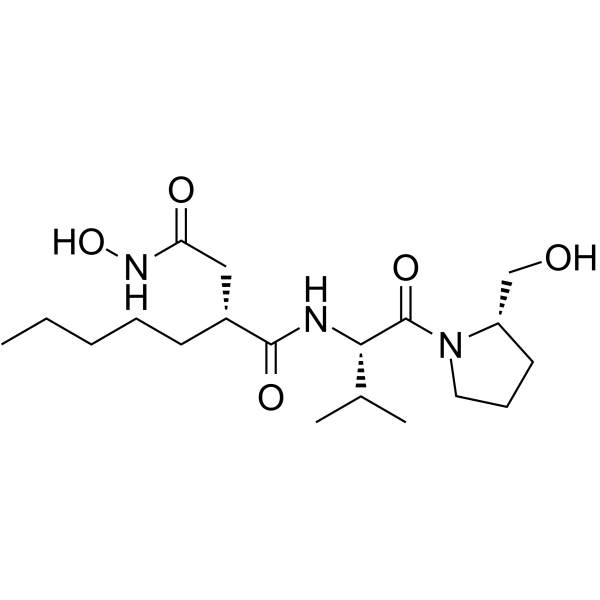Actinonin (Synonyms: (-)-Actinonin) 纯度: 99.30%
Actinonin ((-)-Actinonin) 是一种由放线菌产生的天然抗菌剂。Actinonin 抑制氨肽酶 M,氨肽酶 N 和亮氨酸氨肽酶。Actinonin 是一种有效的可逆肽去甲酰基酶 (PDF) 抑制剂,Ki 为 0.28 nM。Actinonin 还抑制 MMP-1,MMP-3,MMP-8,MMP-9 和 hmeprin α 的 Ki 值分别为 300 nM,1,700 nM,190 nM,330 nM 和 20 nM。Actinonin 是一种凋亡诱导剂,具有抗增殖和抗肿瘤活性。

Actinonin Chemical Structure
CAS No. : 13434-13-4
| 规格 | 价格 | 是否有货 | 数量 |
|---|---|---|---|
| Free Sample (0.1-0.5 mg) | Apply now | ||
| 10 mM * 1 mL in DMSO | ¥1100 | In-stock | |
| 5 mg | ¥1000 | In-stock | |
| 10 mg | ¥1800 | In-stock | |
| 25 mg | ¥3800 | In-stock | |
| 50 mg | ¥6800 | In-stock | |
| 100 mg | ¥11500 | In-stock | |
| 200 mg | 询价 | ||
| 500 mg | 询价 |
* Please select Quantity before adding items.
Actinonin 相关产品
•相关化合物库:
- Natural Product Library Plus
- Bioactive Compound Library Plus
- Anti-Infection Compound Library
- Apoptosis Compound Library
- Metabolism/Protease Compound Library
- Natural Product Library
- Anti-Cancer Compound Library
- Differentiation Inducing Compound Library
- Antibacterial Compound Library
- Antibiotics Library
- Anti-Pancreatic Cancer Compound Library
- Microbial Metabolite Library
- Angiogenesis Related Compound Library
| 生物活性 |
Actinonin ((-)-Actinonin) is a naturally occurring antibacterial agent produced by Actinomyces. Actinonin inhibits aminopeptidase M, aminopeptidase N and leucine aminopeptidase. Actinonin is a potent reversible peptide deformylase (PDF) inhibitor with a Ki of 0.28 nM. Actinonin also inhibits MMP-1, MMP-3, MMP-8, MMP-9, and hmeprin α with Ki values of 300 nM, 1,700 nM, 190 nM, 330 nM, and 20 nM, respectively. Actinonin is an apoptosis inducer. Actinonin has antiproliferative and antitumor activities[1][2][3][4][5]. |
IC50 & Target |
Ki: 0.28 nM (Peptide deformylase (PDF))[2], 300 nM (MMP-1), 1,700 nM (MMP-3), 190 nM (MMP-8), 330 nM (MMP-9)[3], and 20 nM (hmeprin α)[5] |
||||||||||||||
|---|---|---|---|---|---|---|---|---|---|---|---|---|---|---|---|---|---|
| 体外研究 (In Vitro) |
Actinonin inhibits cell growth in various human tumor cell lines. The IC50 of 4, 6.9, 12.8, 16.6, 27.4, 15.7 and 49.3 μM for Raji cells, MDA-MB-468 cells,PC3 cells, SK-LC-19 cells, Hela cells, HT-1080 cells and AL67 cells, respectively[1]. MCE has not independently confirmed the accuracy of these methods. They are for reference only. |
||||||||||||||||
| 体内研究 (In Vivo) |
Actinonin has been safely administered to mice as an antibiotic at doses up to 400 mg/kg. Actinonin does not appear to have significant toxicity to normal tissues, despite its antitumor activity in vitro. Remarkably, Actinonin exhibits significant antitumor activity when given i.p. or orally in a CWR22 human prostate tumor xenograft model in nude mice. During treatment, the animals show no signs of toxicity[1]. MCE has not independently confirmed the accuracy of these methods. They are for reference only. |
||||||||||||||||
| 分子量 |
385.50 |
||||||||||||||||
| Formula |
C19H35N3O5 |
||||||||||||||||
| CAS 号 |
13434-13-4 |
||||||||||||||||
| 运输条件 |
Room temperature in continental US; may vary elsewhere. |
||||||||||||||||
| 储存方式 |
|
||||||||||||||||
| 溶解性数据 |
In Vitro:
DMSO : 50 mg/mL (129.70 mM; Need ultrasonic) 配制储备液
*
请根据产品在不同溶剂中的溶解度选择合适的溶剂配制储备液;一旦配成溶液,请分装保存,避免反复冻融造成的产品失效。 In Vivo:
请根据您的实验动物和给药方式选择适当的溶解方案。以下溶解方案都请先按照 In Vitro 方式配制澄清的储备液,再依次添加助溶剂: ——为保证实验结果的可靠性,澄清的储备液可以根据储存条件,适当保存;体内实验的工作液,建议您现用现配,当天使用; 以下溶剂前显示的百
|
||||||||||||||||
| 参考文献 |
|
所有产品仅用作科学研究或药证申报,我们不为任何个人用途提供产品和服务
